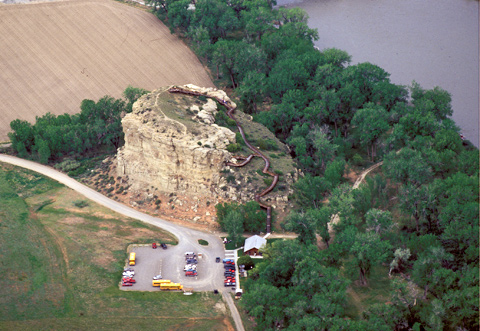For countless generations before William Clark arrived on 25 July 1806, a conspicuous sandstone formation on the Yellowstone river now officially called Pompeys Pillar had been a distinctive feature in the homeland of the Crow Indians. It marked a major trade point, an easy river crossing, a favorite gathering place, and a communication center.
“At 4 P M arrived at a remarkable rock,” wrote Clark, “situated in an extensive bottom. . . . This rock I ascended and from it’s top had a most extensive view in every direction. This rock which I shall Call Pompy’s Tower is 200 feet high and 400 paces in secumphrance and only axcessible on one Side.”
The Crows called the rock is-biia ah-naac’-he’, meaning “Where the Mountain Lion Sits.” Unaware of that, Clark memorialized it with “Pomp,” his nickname for the Charbonneaus’ “butifull promising Child ,” Jean Baptiste Charbonneau. Clark left no clues as to the source or meaning of his pet name for the boy, but Nicholas Biddle incongruously assumed that the landmark’s name alluded to Pompey’s Pillar, a ninety-two-foot red granite Corinthian monument erected in Alexandria, Egypt about the close of the Fourth Century A.D., originally dedicated not to a Roman general named Pompey but to the Emperor Diocletian.
“The natives have ingraved on the face of this rock the figures of animals &c. near which I marked my name and the day of the month & year,” Clark noted. His inscription is the only remaining physical evidence anywhere of the passing of the Lewis and Clark Expedition, thanks mostly to the Crows, who could have considered it a desecration of one of their sacred places and obliterated it long ago. Meanwhile, the Indian pictographs have weathered away. Today the rock bears about 2,500 names that have been scratched and scribbled on it by more recent passers-by.[1]For a fuller discussion, see Pompeys Pillar and Trail Graffiti.
From Discovering Lewis & Clark from the Air
Photography by Jim Wark
Text by Joseph Mussulman
Reproduced by permission of Mountain Press
Notes
| ↑1 | For a fuller discussion, see Pompeys Pillar and Trail Graffiti. |
|---|
Experience the Lewis and Clark Trail
The Lewis and Clark Trail Experience—our sister site at lewisandclark.travel—connects the world to people and places on the Lewis and Clark Trail.
Discover More
- The Lewis and Clark Expedition: Day by Day by Gary E. Moulton (University of Nebraska Press, 2018). The story in prose, 14 May 1804–23 September 1806.
- The Lewis and Clark Journals: An American Epic of Discovery (abridged) by Gary E. Moulton (University of Nebraska Press, 2003). Selected journal excerpts, 14 May 1804–23 September 1806.
- The Lewis and Clark Journals. by Gary E. Moulton (University of Nebraska Press, 1983–2001). The complete story in 13 volumes.


